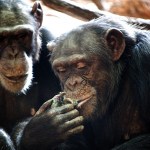primate
Photo of an African Green Monkey by Sharp Photography, via Wikimedia Commons
Humans are not the only primates that spontaneously develop hypertension. A new study published in the American Journal of Physiology - Regulatory, Integrative and Comparative Physiology, examined the development of spontaneous hypertension in African Green Monkeys (Chlorocebus aethiops sabaeus; aka: vervets). The team measured blood pressure in 424 adult monkeys and found that 37% had high blood pressure (SBP: 172.0±2.2 mmHg) and an additional 18% had borderline hypertension. Like humans, the prevalence of…
... or any other human language for that matter. Even though both monkeys and humans have the anatomical tools for speech, only humans communicate in this manner. Researchers had assumed, incorrectly, that the anatomy of the vocal tract (lips, tongue, larynx) of monkeys was not capable of producing speech. A new study published in Science Advances shows instead that it is all in our heads.
The researchers came to this conclusion after creating x-ray videos of macaques making sounds and eating. They used these videos to create computer models that could translate the…
Although slimmer, calorie restricted rhesus monkeys (left) do not live longer than their age-matched counterparts (right). (Housing shown was for photo purposes only; Image: National Institutes of Aging; Austad SN, Nature 2012).
Despite promising results in mice and rats that calorie restriction prolongs lifespan, results from the US National Institute on Aging (NIA) in Bethesda, MD were just published in Nature last week and concluded that calorie restriction for primates had no effect on longevity.
In the study, young and old rhesus monkeys were fed either control…
A collared brown lemur (Eulemur collaris) baby, photographed at the Bronx Zoo.
"Dinah", a young female gorilla kept at the Bronx Zoo in 1914. From the Zoological Society Bulletin.
Frustrated by the failure of gorillas to thrive in captivity, in 1914 the Bronx Zoo's director William Hornaday lamented "There is not the slightest reason to hope that an adult gorilla, either male or female, ever will be seen living in a zoological park or garden." Whereas wild adult gorillas were "savage" and "implacable" beasts which could not be captured (a photo of a sculpture included in Hornaday's article depicts a gorilla strangling one man, brandishing another about with its other…
A young lowland gorilla (Gorilla gorilla), photographed at the Bronx Zoo.
Today is the big day!
And not merely because it is TGIF* day.
The theme "everything you know is sort of wrong" is familiar to readers on this blog. It is an underlying theme for much of what happens here. Every now and then that theme is manifest overtly, as in the Falsehoods posts, which are, as we speak, being revised, expanded, and reissued.
Well, starting this evening and running for an indeterminate amount of time (but probably a few weeks or so) "Everything you know is sort of wrong" is not just a phrase to keep in your head all the time as you are walking around doing stuff. It's…
New research finds chimpanzees follow prestigious models when learning new tasks. Monika Thorpe / Creative CommonsIf one were to play psychiatrist to the natural world, most human beings would be committed for our certifiable obsession with other peoples' behavior. We compulsively examine, study, appraise, size up, and scope out what those around us are doing and then gossip with others about what we've seen or heard. New ideas or behaviors are especially compelling and will often have cultural critics…
A male lowland gorilla (Gorilla gorilla), photographed at the Bronx Zoo.
A baby Coquerel's sifaka (Propithecus coquereli), photographed at the Bronx Zoo.
What is culture? One simple definition might be: a distinctive behavior shared by two or more individuals, which persists over time, and that ignorant individuals acquire through socially-aided learning.
There are at least four different ways to learn a particular behavior or problem-solving strategy. That is to say, there are four different ways to learn. The first is social facilitation, in which one individual does the same thing as the demonstrator at the same time. Essentially this is a situation of on-line matching of motor actions. For example, I might learn the steps to a complicated…
In the Fayum desert of northern Egypt, not too far from the banks of the Nile, the vestiges of ancient forests are preserved in the sand-covered strata. The fossils are ghosts of a vanished oasis in which prehistoric cousins of modern elephants wallowed in lush wetlands and a host of ancient primates scrambled through the trees, and despite being known as one of the world's best fossil sites for over a century paleontologists are continuing to discovery new species from the desert rock. The trouble is that not all these new species are easily classified.
Approximately 37 million years ago,…
Utah may seem like an odd place to search for primates, but you can find them if you know where to look. Although scrubby and arid today, between 46-42 million years ago what is now the northeastern part of the state was a lush forest which was home to a variety of peculiar fossil primates. Called omomyids, these relatives of living tarsiers are primarily known from teeth and associated bits and pieces of bone, but newly discovered postcranial remains may provide paleontologists with a better idea of how some of these ancient primates moved.
For most of their early evolution omomyids were…
A leopard (Panthera pardus). Image from Wikipedia.
SK-54 is a curious fossil. The 1.5 million year old skullcap represents a juvenile Paranthropus robustus, one of the heavy-jawed hominins which lived in prehistoric South Africa, but there is something that makes this skull fragment particularly special. Near one of the sutures along the back of the skull are two neat puncture marks, the hallmark of a leopard.
Even though it was initially proposed that SK-54 had been murdered by another australopithecine wielding a weapon of bone or horn, in the late 1960's the paleontologist C.K. Brain…
The partial faces of Anoiapithecus (left), Pierolapithecus (center), and Dryopithecus (right). (Images not to scale)
Our species is just one branch of a withering part of the evolutionary tree, the great apes. Along with the handful of species of chimpanzees, gorillas, and orangutans, we are all that is left of the hominids, and considering the threats our close relatives face we could very soon be the only great apes left. It has not always been this way. During the swath of prehistory ~23-5 million years ago known as the Miocene a variety of ape species inhabited forests through much of…


